Whether we're talking about culinary applications, adaptogens, or "consciousness expansion", we've all seen how mushrooms have generated a lot of hype in recent years.

Get ready for a master class in cordyceps -- and the most fun way to get them in is through Fungies Gummies!
While adaptogenic mushroom blends have downright exploded, Fungies has been quietly setting the trend from another angle: single-ingredient mushroom supplements. We recently covered their nerve-growing and brain-boosting lion's mane supplement, which you can read about in our article titled Fungies Lion's Mane Gummies: Gelatinous Neurogenesis.
Thanks largely to Fungies, previously-obscure edible fungi now line the shelves of Walgreens, a deal that has added some incredible possibilities to consumers' supplement arsenal.
Introducing Fungies Cordyceps
Today we're talking about the Fungies' Cordyceps Gummies, a deliciously-edible supplement offering 50 milligrams of 10:1 Cordyceps militaris extract per 1-gummy serving, equivalent to 500 milligrams of raw cordyceps. These are generally the athletically-minded mushrooms, as discussed in greater detail in this article. With the Mango and Pineapple flavors, they're also some of the most delicious gummies we've ever tasted - despite there being cordyceps inside!
We get into those details below -- first, check our coupon-powered deals and sign up for our Fungies news so that we hit you up with new deals, flavors, products, and any other promotions:
Fungies Cordyceps Mushroom - Energy Gummies – Deals and Price Drop Alerts
Get Price Alerts
No spam, no scams.
Disclosure: PricePlow relies on pricing from stores with which we have a business relationship. We work hard to keep pricing current, but you may find a better offer.
Posts are sponsored in part by the retailers and/or brands listed on this page.
This area is reserved for Team PricePlow's upcoming videos.
Subscribe to our channel and sign up for notifications so you catch it when it goes live!
Fungus use Cordyceps Militaris, which boasts a better body of research and shouldn't be confused with cordyceps sinensis, but we still want to cover the general background of the mushroom family:
Cordyceps – History and Background
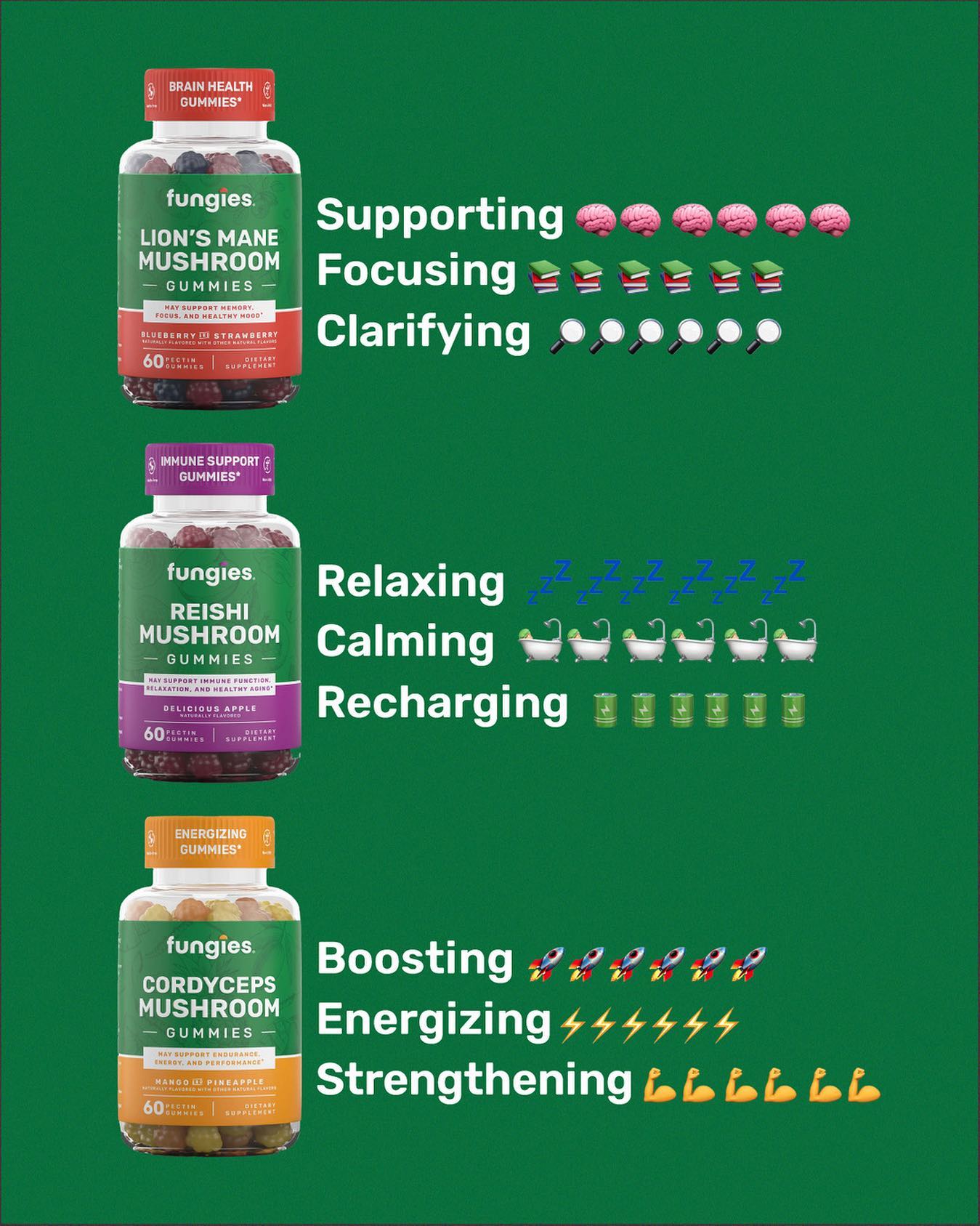
You can read our introductory article on Fungies Mushroom Gummies
This is because Cordyceps doesn't grow in the places or manner traditionally associated with edible fungi. Rather than feeding itself by means of a subterranean mycelium that absorbs nutrients from its surrounding environment, wild Cordyceps -- especially the sinensis form -- can survive and propagate by parasitizing and controlling the behavior of insects,[1] basically turning them into zombie bugs that symbiotically position themselves for ideal fungal spore dispersal.
Zombies might be trendy in today's pop culture (the show Last of Us made a scientifically-incorrect but entertaining leap from the above paragraph by applying it to humans), but make no mistake, the medicinal use of this medicinal fungus is no passing fad. Cordyceps has a history of use that was first formally documented in the 18th century by Qing Dynasty scholars, although it probably stretches back to about 2,000 years ago.[2]
In fact, of all the adaptogenic fungus and mushroom supplements currently on the market, Cordyceps is arguably the most powerful. As we will see, there is almost no dimension of human health that isn't touched by its therapeutic properties.
Cordyceps sinensis vs. Cordyceps militaris
At this point, we need to draw a distinction between Cordyceps sinensis, which is the traditional species, and Cordyceps militaris, the species used to produce Fungies' Cordyceps.
No Insects Were Harmed in the Production of Fungies' Cordyceps
First of all, if the whole concept of ingesting a parasitic fungus sounds creepy to you, there's nothing to worry about here. The Cordyceps used by Fungies didn't zombify any bugs. That's because the militaris species of Cordyceps, in contrast to sinensis, can be cultivated under sterile conditions at scale, which is the reason Fungies opted to use it.
And either way, however unpleasant Cordyceps may be for insects, it's great for humans. Hopefully this doesn't need to be said, but there is zero risk of human Cordyceps infection under any circumstances.
Is militaris better than sinensis?
We'll go into the details of this, but the short answer is yes. In fact, one of Cordyceps' most beneficial bioactive constituents, cordycepin (3′-deoxyadenosine), is a whopping 90 times more abundant in militaris than it is in sinensis.[3] So let's take a closer look at what's in Fungies Cordyceps Gummies:
Cordyceps militaris Research
Again, although Cordyceps sinensis is the traditional cordyceps, the relative ease of producing and sourcing militaris means there's just as much research on it, if not more, than there is on sinensis.
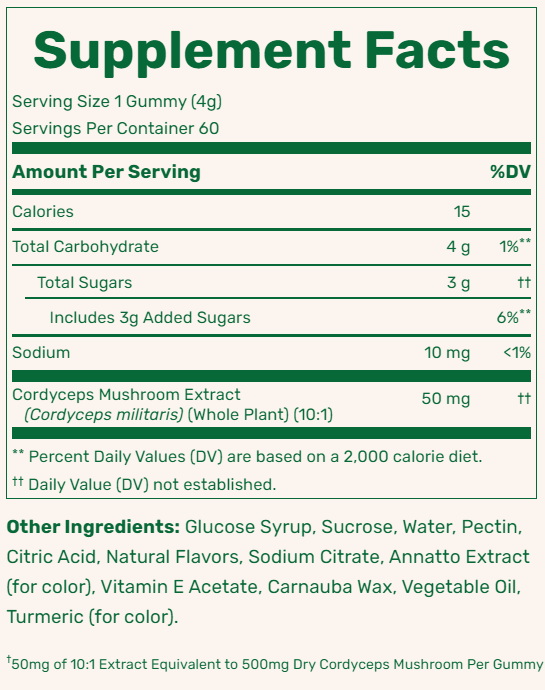
50 milligrams of 10:1 Cordyceps Militaris extract is the equivalent of 500 milligrams of dry cordyceps militaris
This means you don't have to take anyone's word that militaris is just as good – there's plenty of militaris-specific research for us to discuss - and it doesn't suffer from many of the identification problems that plagued sinensis a few decades back
-
Improved Oxygen Uptake and Exercise Performance
We most commonly see Cordyceps used in blends designed to improve oxygen uptake, thereby enhancing athletic performance. There's a solid evidentiary basis for this application.
A 2016 study in mice found that when treated with militaris extracts, the mice performed much better on a forced swimming test. According to the authors of the study, the polysaccharides in militaris can significantly improve key metrics of antioxidant status and physical endurance. For example, militaris-treated mice had significantly more superoxide dismutase, glutathione, and other key endogenous antioxidants. They also had lower levels of malondialdehyde, which is a commonly used measure of oxidative stress.[4]
The research on this subject isn't limited to animals – human trials have borne out these effects as well.
For example, in a 2004 randomized, double-blind, placebo-controlled study conducted in a cohort of 37 adults aged 58 to 78, those who received a 3,000-milligram daily dose of militaris extract had a 7% higher VO2max than the placebo group at the end of the 12-week study period.[5]
In one randomized controlled trial, healthy adults ages 18-35 showed significant improvements in multiple dimensions of aerobic fitness with a mushroom blend led with cordyceps militaris. VT = ventilatory threshold, TTE = time to exhaustion.[https://www.ncbi.nlm.nih.gov/pmc/articles/PMC5236007/]
A 2017 study with a similar design, except carried out in healthy young adults aged 18-35, yielded similar findings. Those who got the Cordyceps militaris extract saw significant improvements in VO2max, ventilatory threshold, and time to exhaustion by the end of the study period, compared to the placebo control group.[6]
-
Mitochondrial Health
This is a big one – except for maybe metabolic health, which we'll address below. There is probably nothing more fundamental or important for overall health, wellness, and longevity than mitochondrial health.
After all, as most of us know, mitochondria are the powerhouses of cells, responsible for generating all the energy your body needs to live. If something goes wrong with this energy-producing mechanism, the consequences can be dire.
Lipid peroxidation (LPO) is a process in which free radicals break down the carbon bonds within fatty acids, particularly polyunsaturated fatty acids (PUFAs). This process creates lipid peroxides, which are highly toxic and can damage mitochondria.[7] According to a 2010 mouse study, treatment with militaris extract significantly can significantly reduce LPO.[8]
The researchers found that cells taken from mice who received militaris exhibited significantly less mitochondrial swelling,[8] which is evidence that the mitochondria were subjected to significantly less oxidative stress. But the researchers also found that militaris can decrease the concentration of thiobarbituric acid reactive substances (TBARS), basically a direct measure of LPO.[8]
The connection between mitochondrial health and longevity
A study in healthy mice found that treatment with the CS-4 militaris extract significantly extended their lifespan. While all the control (i.e., not treated with militaris) mice died before reaching 3 years of age, CS-4 extended lifespan by 10 to 66 days at 50% survival and 45 to 153 days at 10% survival.[9] In other words, once 50% of the militaris-treated mice had died, the remaining mice were anywhere from 10 to 66 days older than the average control mouse – and 45 to 153 days older when only 10% of the mice were still living.
At 25 months old, mice treated with CS-4 militaris extract showed mitochondrial gene expression closely resembling that of much younger mice.[9]
The authors of this study observed that genes related to mitochondrial function were much better expressed in the militaris-treated mice as they aged. In fact, their mitochondrial gene expression looked a lot like that of mice one-fifth their age.[9]
A 2015 study in fruit flies showed similar results: Supplementation with Cordyceps sinensis significantly prolonged survival time of flies exposed to a mitochondria-damaging toxin.[10]
-
Anti-Inflammatory
Chronic inflammation is a serious and growing public health problem. It has been associated with cardiovascular disease, cancer, diabetes, kidney dysfunction, non-alcoholic fatty liver disease (NAFLD), immune dysregulation, and neurological degeneration.[11]
We've written many times before on the PricePlow Blog about how certain features of the modern environment – EMF exposure, xenoestrogen endocrine disruptors, sedentary lifestyle, and PUFA-rich seed oils, to name a few – encourages runway inflammatory processes in the human body, spelling disaster for health and longevity.
Fungies Lion's Mane Mushroom Gummies: Powerful adaptogenic mushrooms in a delicious package.
Fortunately for us, Cordyceps militaris appears to be a powerful anti-inflammatory weapon in our supplement arsenal.
In vitro studies consistently show that militaris extracts can decrease human cells' production of inflammatory interleukin cytokines[12-14] and tumor necrosis factor alpha (TNF-alpha)[12] by downregulating the nuclear factor kappa B (NF-κB) pathway.[15] This effect has also been replicated in vivo with animals.[15]
It can also inhibit the expression of inducible nitric oxide synthase (iNOS),[14,16] which is responsible for generating immune-related inflammatory responses.
Cordyceps militaris has also been identified as a cyclooxygenase-2 (COX2) inhibitor,[17] which is illustrative as COX2 is the same mechanism of action behind the anti-inflammatory effects of aspirin and ibuprofen.[18]
Mouse studies have found that militaris can reduce inflammation in airways[19] and skin tissue.[16]
-
Metabolic Health – Insulin-Sensitizing and Anti-Diabetic
As we've written many times on the PricePlow Blog, optimal metabolic health is crucial for the achievement of pretty much any health-related goal.
So many aspects of health are downstream from the way the body handles glucose and fatty acids. Insulin resistance and the dreaded metabolic syndrome, which can culminate in type 2 diabetes, are associated with serious and potentially deadly diseases like atherosclerosis, hypertension, hyperglycemia, and chronic inflammation.
Most of the traditional health tonics we cover turn out to have some kind of anti-diabetic effect, and Cordyceps militaris is no exception.
One caveat about the research on Cordyceps and diabetes: Although the in vitro and animal studies we've discussed are promising, we're not aware of any double-blind, randomized, placebo-controlled studies exploring the use of Cordyceps to treat diabetes in humans.
So, although it's clear that Cordyceps has some kind of anti-diabetic activity, its therapeutic value in human diabetes has yet to be established.
In vitro: improves pancreatic cell health
One in vitro study found that Cordyceps not only protected cultured pancreatic cells from being damaged by peroxide, but actually enhanced their function.[20] In theory, this should translate to improved insulin secretion in vivo.
Reduces blood glucose in diabetic rats
Animal studies have borne this out. For example, in one 2006 study where researchers gave militaris extracts to diabetic rats, the extracts dose-dependently reduced the rats' blood glucose levels.[21]
The same study included groups of rats that received extracts of Cordyceps sinensis, and the militaris extracts did much better on average. The authors of the study explicitly attribute this result to the naturally higher potency of the militaris fungi – i.e., its higher content of bioactive constituents like cordycepin.[21]
Another point of interest in this study is that all the militaris extracts decreased the rats blood glucose, regardless of which part of the Cordyceps fungus they were taken from. So whether it was fruiting body extract, a mycelium extract, or just bioactive polysaccharides from Cordyceps, they all reduced blood glucose by anywhere from 60% to 80%, on average.[21]
This study also found that one of the militaris extracts, CM001, was capable of reducing blood glucose to levels nearly equivalent to those of a normal non-diabetic rat.[21]
Why militaris is great – cordycepin
Remember the bioactive constituent we discussed earlier, cordycepin, which is much more abundant in militaris than in sinensis? As it turns out, some researchers believe cordycepin is primarily responsible for the anti-diabetic effect of Cordyceps.[20] This is one great example of the many advantages that militaris has over sinensis.
In fact, a study from 2015 found that isolated cordycepin can dose-dependently reduce hyperglycemia in diabetic mice.[22]
Of course, that study used extremely high doses of cordycepin, but it does establish the principle that when it comes to benefiting from anti-diabetic effects of Cordyceps, more cordycepin is better.
Anti-diabetic dose
So how much cordyceps do we need to get the anti-diabetic effect? Again, because there's no research in humans, the answer is unclear: We do not have enough information to draw an exact comparison between the extracts used in animal studies and the extract used in Fungies' Cordyceps.
Still, though, we can be reasonably certain that Fungies' Cordyceps is in the ballpark of the doses needed to improve glycemic control through militaris supplementation. According to Fungies, a 50-milligram dose of their 10:1 extract is equivalent to 500 milligrams of whole Cordyceps, and the human equivalent of the CM001 doses used in the 2006 rat study is in the 1-2 gram range.[21]
You can learn about the other Fungies offerings in our article titled Fungies Lion’s Mane Gummies: Gelatinous Neurogenesis.
Flavors Available
At the time of press, Fungus has one variation for their Cordyceps Gummies: Mango and Pineapple. An up-to-date list of flavors is available below:
Conclusion: The Most Delicious Way to Take Cordyceps
Fungies' Cordyceps is a fun and creative way to add Cordyceps militaris to your diet. In our opinion, the biggest question about this supplement is simply, how many gummies should I eat? Again, it's hard to come up with a precise answer in light of the differing extraction techniques and extract potencies, but given the 10:1 strength ratio of the Fungies extract, we think 2 to 4 gummies per serving is in the same dosage ballpark as most animal and human studies.
Finally, we want to reiterate that if you're worried about the militaris species being somehow inferior to the more traditional sinensis, don't be. There's good evidence that militaris is actually better.
Fungies Cordyceps Mushroom - Energy Gummies – Deals and Price Drop Alerts
Get Price Alerts
No spam, no scams.
Disclosure: PricePlow relies on pricing from stores with which we have a business relationship. We work hard to keep pricing current, but you may find a better offer.
Posts are sponsored in part by the retailers and/or brands listed on this page.
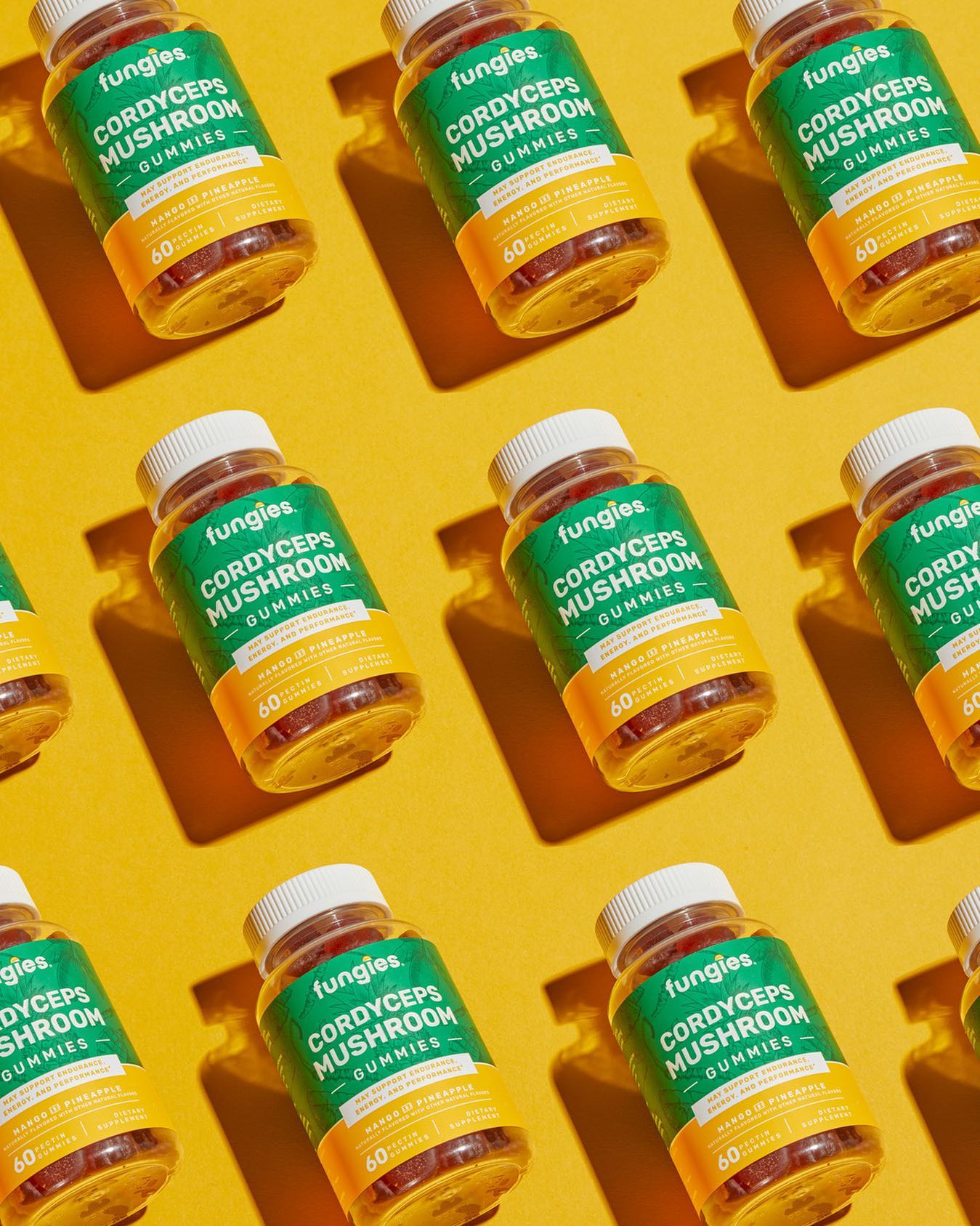
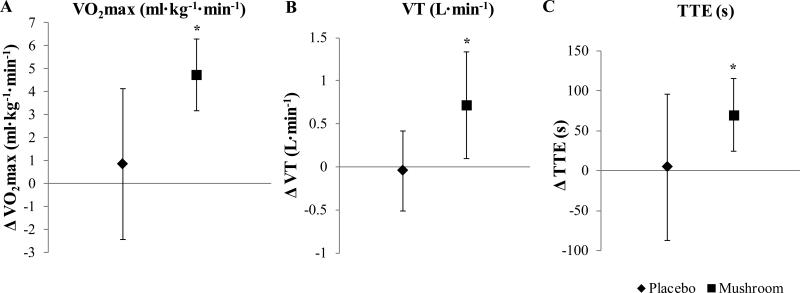


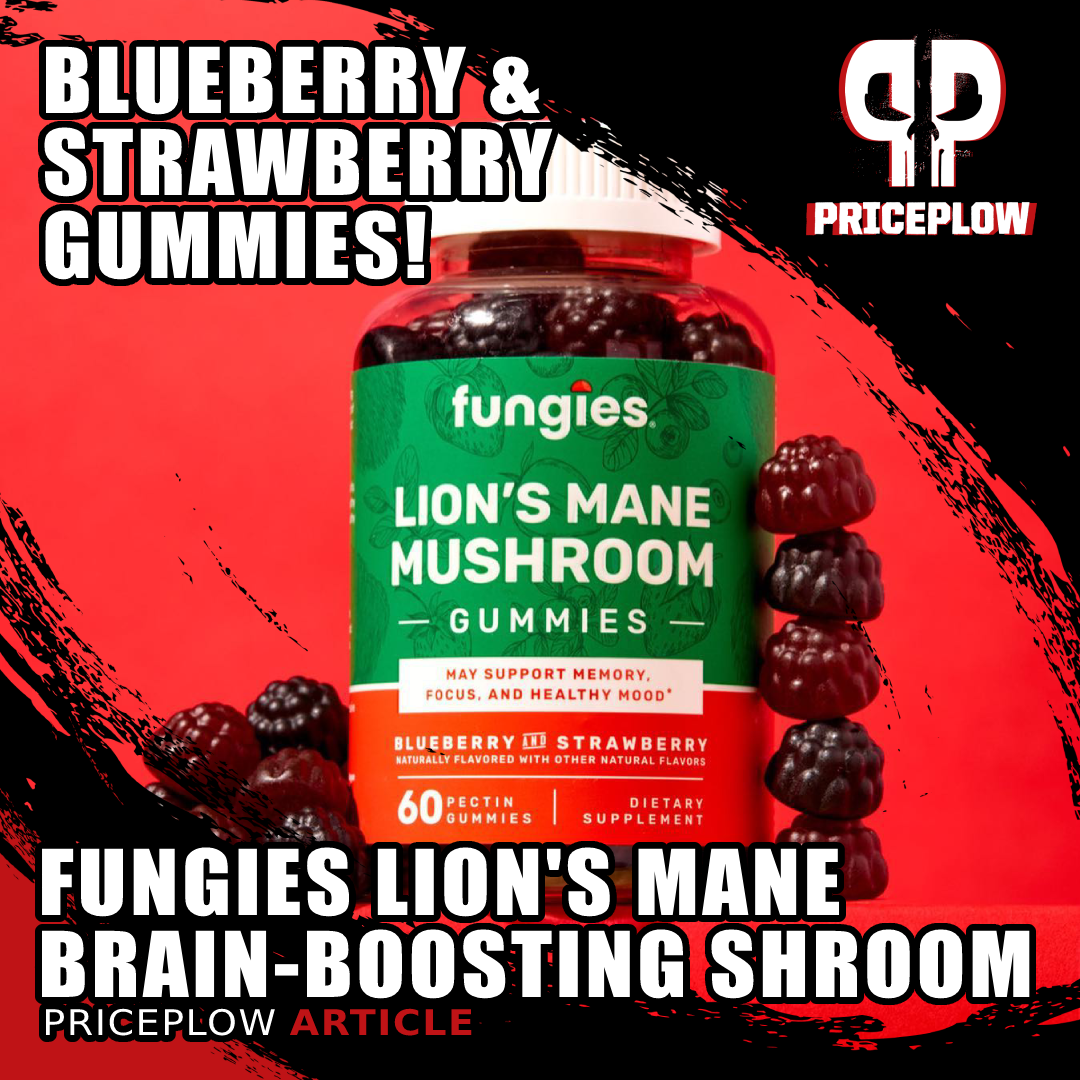
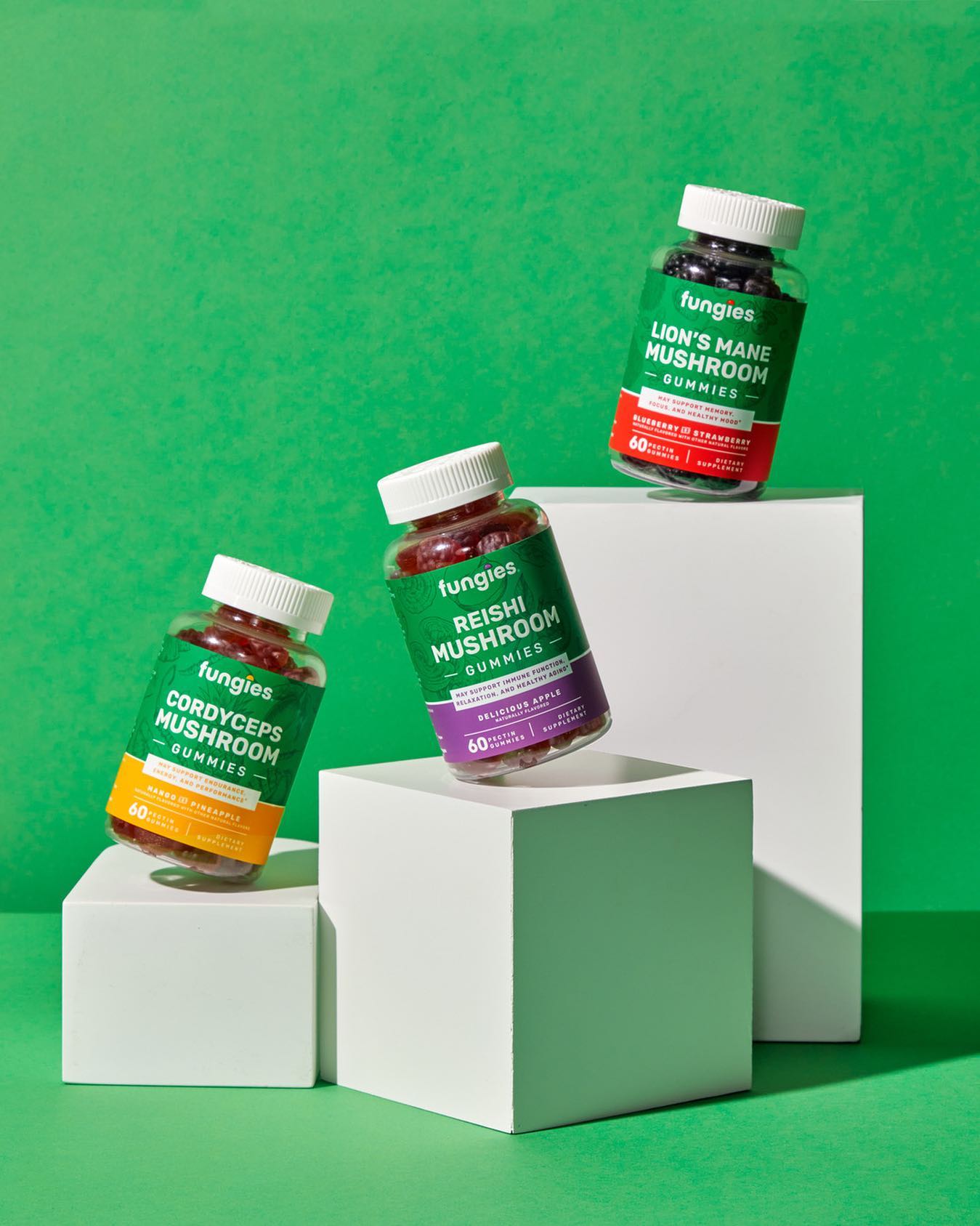
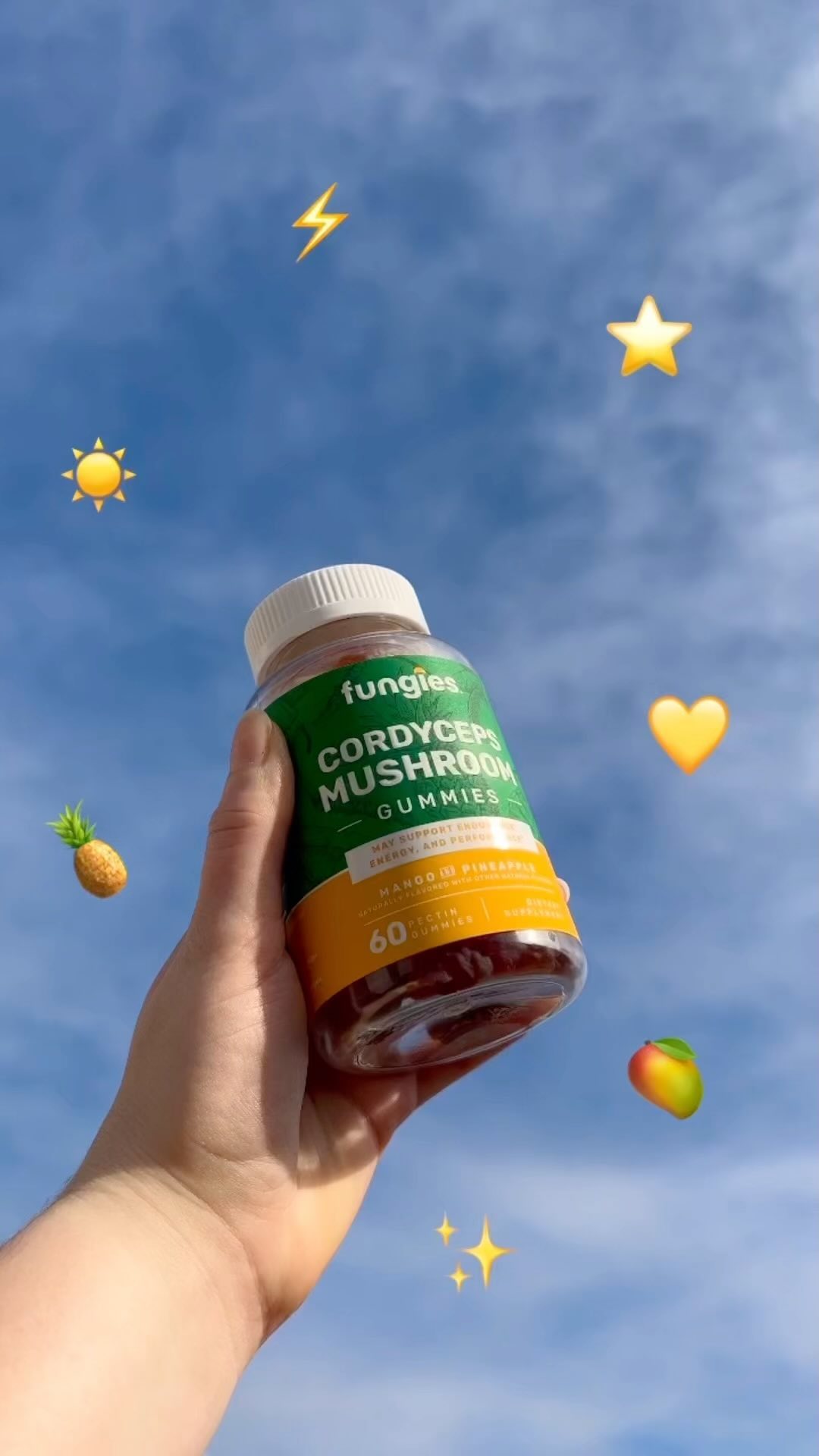



Comments and Discussion (Powered by the PricePlow Forum)